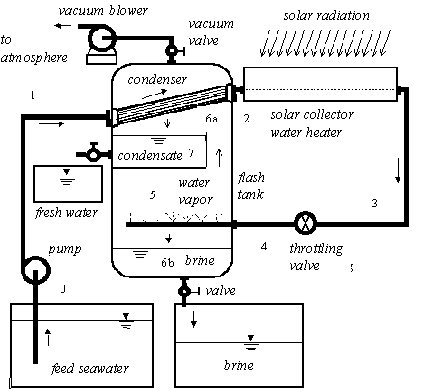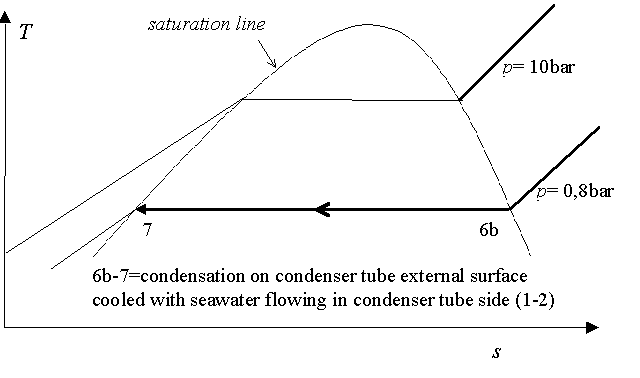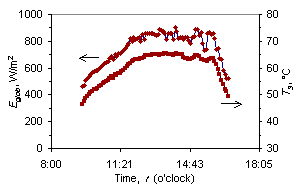| ----------------- |
 |
---------------- |
|
Berlin, 16.06.2001
|
||
| Makalah:
Experimental Analysis of Flash Evaporation Desalination with Solar Energy Uyung Dinata,
Jaya Kurniawan, Adly Havendry
Abstract A seawater desalination system with flash evaporation using solar energy was tested in producing fresh water from seawater. The system can effectively evaporate seawater with throttling and flashing processes in a flash tank. In the system, the cooling fluid from the seawater itself condenses water vapor, therefore, no additional cooling system is required. Parameters influencing on the fresh water capacity are heater outlet temperature and feed seawater capacity. The higher heater outlet temperature can increase the mass transfer rate of water vapor in the tank. Also, the higher the feed seawater capacity, the higher the vapor product rate. But in a critical condition, if the feed seawater capacity in the collector heater is increased, the flash tank temperature decreases, therefore, the fresh water capacity could also decrease. For that, the optimal feed seawater capacity should be determined in order to operate the desalination system at a maximal fresh water capacity. This was obtained via experiments conducted on a typical flash evaporation desalination system with a solar collector water heater. Keywords
Nomenclature
Introduction
An evaporation desalination system with solar energy can be used to produce fresh water for small islands, agricultural plantations near coast, ships with additional heating energy from exhaust gas, off-shore oil rigs, and industries requiring fresh water in high capacity (Dinata [1]). The other product of a desalination installation is brine (high salt-content water), which can, then, be processed for crystal salt (Dinata [1,2], Havendry [3]). This research
aim is to obtain the characteristics of a desalination system with a flash
evaporation using a solar collector water heater that operates with various
feed seawater capacity. With various seawater capacities, an optimal performance
of the system could be obtained based on the ratio of fresh water condensate
product and heating energy. At such an optimal ratio, the installation
could operate in an optimal capacity, which produces maximal fresh water
capacity with minimal heating power.
. |
||
| ..
--- |
||
|
Figure 1: Desalination system with flash evaporator (Dinata, [1])
Flash Evaporation
Desalination with Solar Energy
Figure 2: T-s diagram (upper) for the evaporation process and (lower) for the condensation (Dinata, [1]) This desalination process for one-stage stage is illustrated using a temperature-entropy (T-s) diagram in Figure 2. The assumptions for the desalination characteristics analysis include a constant seawater capacity, no heat and mass leakages, negligible pressure drop due to friction loss, neglected kinetic and potential energy changes, a constant seawater specific mass and heat, and thermodynamic properties of seawater approximated with pure water. Therefore, the fresh water condensate capacity for one-stage system is determined (Dinata [1]):
Equation 1 shows mc=f(mw, T3, p5), which means the condensate capacity is function of seawater capacity, collector outlet temperature and flash tank pressure because hfg5=(hg5-hf5) and hg5=hf5=f(p5). The condensate capacity gets higher (with order 3) if mw is increased and proportional to T3, while p5 is constant due to a vacuum blower, so hf5 and hg5 are constant. However, at constant collector heating and with constant pumping and preheating effects, the collector outlet temperature is inversely proportional to the seawater capacity (Equation 2).
The optimal
seawater capacity is known at a maximal fresh water capacity determined
via experiments and these capacities can be used as an optimal specification
of the system.
|
||
|
Experiment
The experiments were conducted in front of Energy Conversion Laboratory, Mechanical Department of Andalas University from 08.00 until 16.00. The experiment was carried out at various valve opening to change seawater capacity. The measurement was conducted every 5 minutes. Experiment data are graphed to known the system characteristics and then, analyzed to know optimal performance of the system based on seawater capacity in producing maximal fresh water capacity. Characteristics and performance diagrams of experiment result were analyzed so we obtained, i.e.: maximal fresh water condensate capacity, optimal seawater capacity and maximal ratio of condensate capacity to heating power.
Figure 3: Solar
radiation intensity and seawater temperature at collector outlet (left)
Result and
Discussion
The analysis
of the experimental results to determine ratio of condensate capacity to
heating power are described as followed:
|
||
| ..
--- |
||
|
- Used heating power for the sea water:
- Averaged heat (Quse) for Dt=5 minutes:
- Total heat obtained, Qt
- Characteristics of the system at various seawater capacity is based on the ratio rt of total amount of condensate and total heating energy determined using:
The analyzed result is shown in Figure 4 illustrating the relationship of the seawater capacity against ratio of condensate amount to heating power for various seawater capacities with a parabolic characteristics curve. The system has the maximal ratio of 0.33kg/kJ, which obtained from the optimum seawater capacity of 0.027kg/s, which can produce maximal fresh water capacity. The maximal fresh water capacity was obtained with an amount of 0.81kg/h
Figure 4: Seawater capacity against ratio of fresh water total amount to total heating energy
Conclusion
and Recommendation
Recommendations
for next developments i.e.: an increase in water vapor quality in the flash
tank can be achieved with decreasing vacuum pressure in the flash tank
and increasing solar collector area so the seawater temperature of collector
outlet is increased.
References
This report is also published in: Proceeding of 5th Indonesian Studentís Scientific Meeting: 171-174, 2000. @2000 ISTECS Europe & PPI Prancis
|
||
| KEMBALI |




 (2)
(2)


